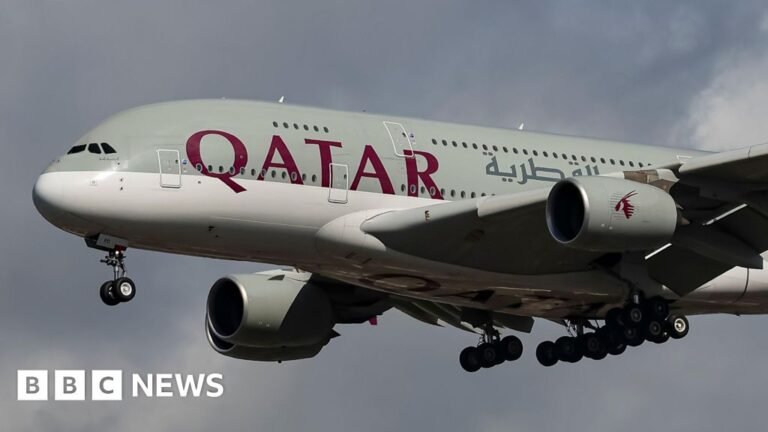Airlines have been cancelling or rerouting flights to and from the Middle East amid the conflict between Israel and Iran.
Qatar’s Hamad International Airport airport, a critical hub in the region, temporarily halted operations on Monday before reopening.
Flights were temporarily paused at Dubai airport in the United Arab Emirates (UAE) as passengers were told to expect further delays and cancellations.
More than a dozen airlines cancelled flights to parts of the region after tension mounted in recent days.
On Monday, Qatar briefly closed its airspace before Iran fired missiles at a US military base in the country, in what it said was retaliation for American strikes against its nuclear sites over the weekend.
Air India said it was stopping all operations to the Middle East and flights to North America’s east coast and Europe. Japan Airlines announced the cancellation of flights from Tokyo to Doha.
In recent years the Gulf region has become one of the world’s busiest flight hubs.
The airports in Dubai and Doha see nearly 400,000 travellers pass through on a daily basis. Another 80,000 passengers travel through the UAE’s other air hub, Abu Dhabi, every day.
For many, these airports are a stopover point for long-haul flights between Europe and Asia or Australia.
Hopes for an easing of tensions rose after US President Donald Trump announced on social media a “complete and total” ceasefire between Israel and Iran.
Israel agreed to the proposal, but on Tuesday accused Iran of attacking it in violation of the ceasefire.
Israeli Defence Minister Israel Katz said he had ordered “intense strikes” on Tehran, but Iran denied firing any missiles, and said it would respond to “any further aggression”.
Rob Liddle, a member of BBC staff who was stranded in Doha en route to Dhaka in Bangladesh, said late on Monday that hundreds of stranded passengers were trying to get food or bedding in the airport lounge while they waited to hear when flights would resume.
There was fear when the missiles were reported to be coming in, he said. But following that, the atmosphere had been “calm”.
Aviation consultant Tim Atkinson said situations like this “cause enormous disruption, not just to flights,” he said.
“There is a fundamental interconnected nature of air travel. So when disruption begins, it spreads almost like wildfire.”
Delays and cancellations are likely to cause significant disruption across and beyond the region, according to aviation expert John Strickland.
“Delays to flights because of following longer routings means more cost to the airlines because they are burning more fuel.” Mr Strickland said.
“It can lead to an airline saying an aircraft is not available when it should be, and in particular crew, because crew are limited by legal rest requirements.”
There is also the question of safety, said Mr Strickland. Many governments have advised against travel to parts of the region, which could force some travellers to cancel their flights.
Decisions on whether to fly to certain destinations could be made on a “day-by-day basis” he said.
According to data from aviation risk consultancy Osprey Flight Solutions, six commercial aircraft have been shot down unintentionally, with three near-misses, since 2001.
Arguably the best known incident was in 2014, when Russian-backed forces in Ukraine shot down Malaysia Airlines Flight 17, killing all 298 people on board.
Russian and Ukrainian airspace has already been closed to most airlines due to the conflict there, diverting even more flights to the Middle East, where they were now being “squeezed” into even smaller spaces, he added.
The conflict in the Middle East has already led to the closure of huge swathes of crucial airspace.
Since Israel launched its offensive, commercial flights have avoided flying over Iran, Iraq, Lebanon, Syria and Jordan.
Roughly 1,400 flights pass through this key corridor between Asia and Europe – but they now either have to fly north over Turkey or south over Saudi Arabia.
